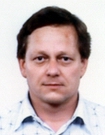
Dalibor BIOLEK
Biography - Dalibor Biolek received the M.Sc. degree in Electrical Engineering from Technical University in Brno, Czech Republic, in 1983, and the Ph.D. degree in Electronics from the Military Academy Brno, Czech Republic, in 1989. He is currently with the Department of EE, University of Defence Brno (UDB), and with the Institute of Microelectronics, Brno University of Technology (BUT), Czech Republic. His scientific activity is directed to the areas of general circuit theory, frequency filters, and computer simulation of electronic systems. For years, he has been engaged in algorithms of the symbolic and numerical computer analysis of electronic circuits with a view to the linear continuoustime and switched filters. He has published over 250 papers and is author of a book on circuit analysis and simulation. At present, he is professor at the BUT and UDB in the field of Theoretical Electrical Engineering. Prof. Biolek is the vice-president of the CAS/COM Czech National Group of IEEE. He is also the president of Commission C of the URSI National Committee for the Czech Republic.
Dalibor BIOLEK
Department of Electrical and Engineering/Microelectronics
University of Defence/Brno University of Technology
612 00 Brno
Czech Republic
E-mail: dalibor.biolek@unob.cz
Abstract – Searching for novel active circuit elements for analog signal processing which would operate on completely different circuit principles than present-day operational amplifiers (OpAmps) is going hand to hand with a research into new circuit structures employing these elements for linear and nonlinear signal processing. It looks like an apparent paradox in the era of advanced technologies of IC manufacturing that the “old” but proven OpAmp circuit principles persist on the production programmes of world-leading factories, whereas the series production of electronic components, working on modern principles, cannot be put through. On the other hand, for example, one cannot fully utilize the claimed advantages of the current mode in comparison to the voltage mode when implementing the application circuits from discrete components. This lecture illustrates the above problem on an example of emulating memristors, memcapacitors, and meminductors, promising circuit elements which represent an extension of the set of conventional R, C, and L elements, via a combination of analog passive and active elements. It is shown that special mutators can serve as effective tools for such emulation, and that the second-generation current conveyors (CCIIs) can play an important role in their synthesis. On the other hand, such emulators should be small enough and supplied by individual mini-batteries. It leads to a requirement of low-voltage low-power building blocks. This lecture describes prototyping of these emulators via today’s off-the-shelf integrated circuits. In the second step, a comparison with other implementations is made on the assumption that some till this time hypothetical active elements are available in the market.